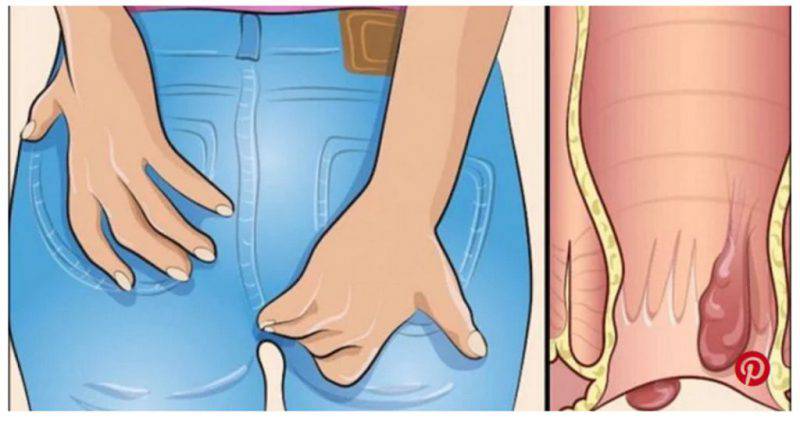Are hemorrhoids bad? Hemorrhoids despite the strong discomfort created, are generally not dangerous for the health of the individual. However, complications related to excessive bleeding (anemia and thrombosis) may arise in an advanced stage of the disease.
hemorrhoids are vascular structures normally present in the anal canal of all people, including perfectly healthy ones. Under certain circumstances these blood vessels can swell beyond measure and become inflamed, thus triggering all those unpleasant ailments indicated by the generic term of hemorrhoids, but better defined as hemorrhoidal disease.
Hemorrhoids are cushions of vascular tissue, therefore a tissue full of blood, spongy, formed by capillaries, arteries and especially veins. Hemorrhoids are located inside the anal canal, firmly anchored to its wall thanks to fibrous ligaments that keep them in place.
From the anatomical point of view, hemorrhoids are divided into internal and external. The internal ones are located inside the anal canal above that imaginary line, called dentate line or pettinea, which divides the anal canal into two parts according to the mucous membrane that covers it. The external hemorrhoids are instead located lower, below this line, at the edge of the anal orifice.

An important difference between the two types of hemorrhoids is pain sensitivity, due precisely to the diversity of the lining mucosa; pain sensitivity is in fact absent for internal hemorrhoids, while it is marked for external ones. But what exactly are hemorrhoids used for? Their function is to contribute, together with the anal sphincter, to both evacuation and continence, therefore to the ability to retain stool, but also liquids and gases.
Being richly vascularized, in fact, hemorrhoids are able to swell and deflate through the inflow and outflow of blood within them. Clearly, when hemorrhoids swell they increase their continence by closing the anus. Conversely, when they are emptied, they facilitate the emission of feces to the outside.
Under normal conditions, Are hemorrhoids bad? Well the presence of hemorrhoids is not really felt. However, since the tissue that lines the anal canal is very loose, hemorrhoids can dilate and become inflamed. The dilation and inflammation of hemorrhoids can cause prolapse, bruising, bleeding or thrombus, that is, the formation of blood clots inside them.
In all these cases we speak of haemorrhoidal or haemorrhoidal pathology. Hemorrhoidal disease can cause annoying anal disorders, such as swelling, itching, burning, pain, bleeding and mucus discharge from the anus. Not surprisingly, etymologically speaking, “hemorrhoid” means loss of blood; this loss, always bright red, can manifest itself in the form of dripping or splashing, or even as the presence of stains on toilet paper, on the toilet or on the faeces. Bleeding and itching are the most common symptoms of inflamed hemorrhoids, often associated with a sense of weight and bulk in the anus.
Among the symptoms attributable to hemorrhoids, anorectal bleeding is also the one to pay more attention to; in fact, in his presence, it is always good to carry out medical examinations to exclude other more serious pathologies, including colorectal cancers. Over time, if not treated properly, hemorrhoids can prolapse, that is, escape from the external anal sphincter. In the more advanced stages, complications such as thrombosis, ie the formation of a blood clot, can arise; this thrombosis can give rise to a very painful acute inflammation.

Another complication is the constriction of prolapsed hemorrhoids due to the contraction of the anal sphincter. Also in this case the patient will complain of acute pain in the anal region. However, it should be borne in mind that in the uncomplicated stages of thrombosis, hemorrhoids are generally not painful.
The combination of burning anal pain at the time of defecation and traces of blood in toilet paper is rather a typical symptom of an anal fissure, that is, a cut in the anus. Even if it is not a serious disease, hemorrhoids should not be neglected. In fact, milder cases can be treated with the topical application of drugs with a decongestant action. However, if there is a worsening of symptoms it may be necessary to resort to a real surgery.
Hemorrhoidal disease is a widespread problem that affects men and women of different ages; establishing the true incidence is difficult, because only a minority of patients consult the doctor. According to some estimates, however, about 5-10% of adults suffer from it, while 50% of the population has suffered, suffers or will suffer from this disease. Less common under the age of 30, inflamed hemorrhoids become quite common after the age of 40/50.
In general, hemorrhoids are more frequent in industrialized countries, also due to the Western lifestyle and eating habits. First of all, if the diet is not balanced and low in fiber, the intestine cannot function properly. The resulting chronic constipation causes prolonged efforts during defecation, which favor inflammation of the hemorrhoids.
There are also foods that have an irritating action, such as sausages, alcohol, chocolate, spices and spicy sauces, all foods that can trigger venous dilation and act as triggers. Overweight and obesity are also predisposing factors, as are defecations that are too hasty or postponed for social reasons.
While this is a common problem for both genders, in some circumstances women become more vulnerable to hemorrhoids. In fact, they can suffer from it during pregnancy or immediately after childbirth; this happens both for the increase in pelvic pressure associated with the presence of the fetus, and for the hormonal changes related to the pregnancy itself.
The abuse of some drugs – in particular contraceptives and laxatives – the sedentary lifestyle and the practice of certain sports, such as horse riding or cycling, also play an important role. Additional causal or favoring factors are the maintenance of an upright position for a long time or the habit of sitting on the toilet bowl for a long time, for example to read.

Among the determining factors there is also a family and personal predisposition, characterized by the weakness of the venous walls and the tendency to varicose veins also in other parts of the body. Finally, hemorrhoids originating from other pathological circumstances, such as portal hypertension resulting from liver cirrhosis, or some pelvic neoplasms, are rarer but of considerable clinical importance.
Among the many proposals, there is a classification of the disorder that distinguishes pathological internal hemorrhoids into four stages of increasing severity. 1st degree hemorrhoids are completely internal vascular swellings, therefore without prolapse outside the anal margin; they give only bleeding and a feeling of fullness.
2nd degree hemorrhoids, on the other hand, prolapse, then come out but only as a result of excessive effort, for example during evacuation or childbirth; very importantly, after having leaked the second degree hemorrhoids return spontaneously.
In this case, in addition to bleeding, itching and discharge of secretions may also be present. In 3rd degree hemorrhoids, the prolapse is independent of the effort, however the hemorrhoidal cushions can still re-enter the anal canal, but only if pushed manually; in addition to the previous ailments, the 3rd degree hemorrhoids cause loss of stool to the outside with soiling of the linen.
Finally, grade 4 hemorrhoids are completely prolapsed and cannot be repositioned inside the anus, so they always remain outside. In addition to the previous symptoms, they also cause pain, often.
The progression of the haemorrhoidal disease in the four stages just described occurs due to a congestion of blood; that is, the latter accumulates in the hemorrhoids dilating them and making them slide downwards.
In fact, the excessive presence of blood tends to exhaust the resistance of the tissues that support and contain the blood vessels, anchoring them to the anal wall. For this reason, in the long run, the weakened blood vessels prolapse, dragging the anorectal mucosa with it. The hemorrhoids thus end up protruding downwards.






